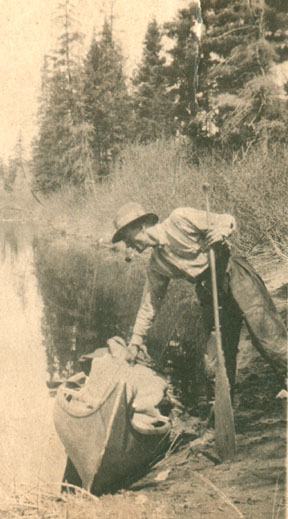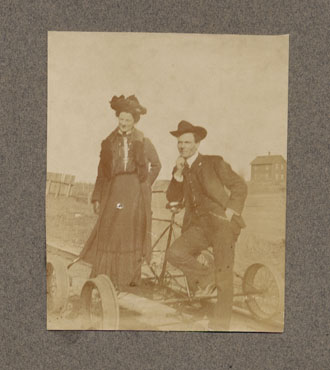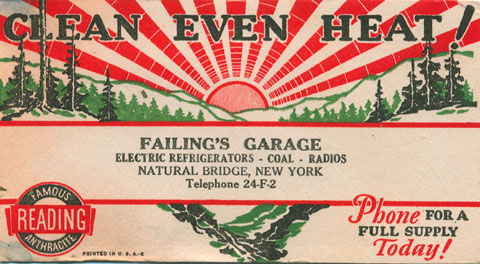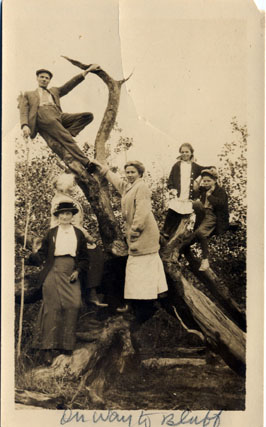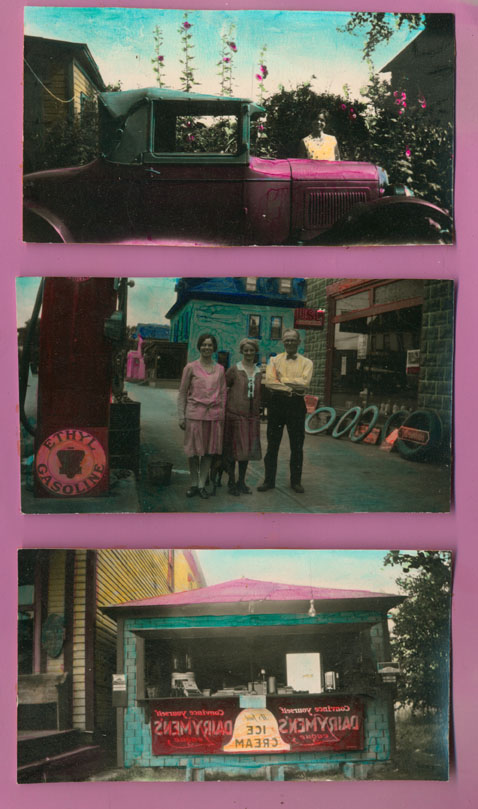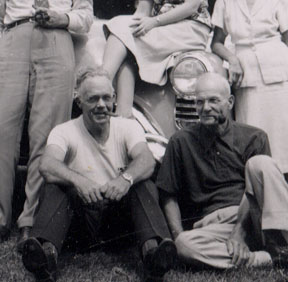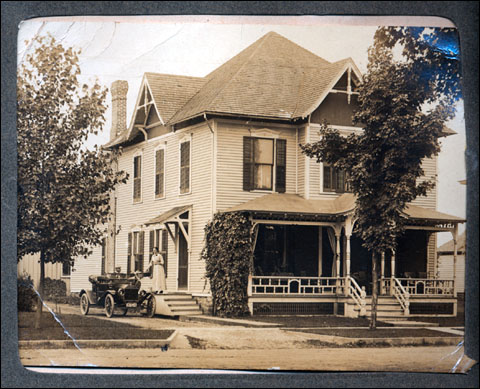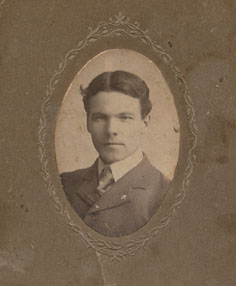
-
H.A.F.
My grandfather Herbert Augustus Failing, whose deeply incised H.A.F. can still be found on some of my hand tools,was the son of a Civil War veteran who had been wounded at the horrific battle of Petersburg. We don't know if Walsteen Failing was among those who tunneled under the Confederate troops and set dynamite there, but he must have been with those who rushed into the crater after the blast and were ambushed by Confederate survivors who had crawled to the rim.
H.A,F. grew up as the returned armies of the north were finishing the clear cutting of the Adirondacks and were proceeding to harvest deer by the herd and send them by the box car to New York. He saw the summers of the Great Confligration, when most of the Adirondacks clearcuts burnt over, including the west shore of Lake Bonaparte. For years after that it must have seemed as if the Civil war had been here in the North.
Structural fires were very common in those days as well, and those included Joseph Bonaparte's original lodge on Lake Bonaparte. But a "New Hermitage" hotel was built to replace the old; its appeal founded on the popular myths of virgin wilderness, the vanished kingdom, lost lovers, and hidden treasure.
H.A.F dreamed of leaving this ruined land to homestead in Oregon, and but for the demands of love and family, he probably would have.
He dropped out of school in tenth grade to work and support the family. He taught himself Morse code and got work as a railroad telegrapher in Great Bend, about thirty miles from Lake Bonaparte. One night at a Fargo Inn dance he met Vera, the only daughter of Dr. and Mrs. Charles Drury of Natural Bridge.
The idea of striking out for Oregon was abandoned soon after, if it had not been given up already. Dr. Drury was willing enough to gain a very useful son, but he was going to keep his daughter, safe, alive, and in sight.
For a while after their marriage, H.A.F. ran the pumping system at Benson Mines. My mother Dorothy Failing was born in 1906 when they still lived there, but before the mine expanded to the point that they had to move the village of Benson Mines to the outskirts of Star lake village, the Failings moved into the house next to the Dr. Drury's in Natural Bridge.
H.A.F. must have been the most generally useful man in the village in those days. At various and overlapping times he ran a neighborhood waterworks from a spring in back of the house, operated a service station, a Whippet truck dealership, and general store with a pharmacy and a pool table upstairs. He did stints as sheriff and church deacon; plus he gardened, cooked, hunted and fished. He was a master of many trades, but fishing was the most serious of all his persuits. Not that he would ever say it was so, or that he would try to making a living at it. Nor did he think of fishing as his religion (which itself he probably didn't take all that seriously) and he would not consciously place fishing above anything else in importance; it just was. Not just important, but serious; sometimes grimly so.
Immediately after the intitial clear-cutting and the first bumper crops of insects on all that open land, the back country trout fishing had been spectacular, but following the local extinction of the beaver and the draining of their impoundments which had maintained the water table, the rivers and the fishing in them declined. Lake Bonaparte, though, was steady, deep, enhanced by daming, and still isolated enough that , with the exception of the Landlocked Salmon, it retained most of its many native species and fishermen had introduced some new ones with bigger mouths. H.A.F. enjoyed some light pan fishing with my grandmather, and she shared some of his enthusiasm for eating fish, especially bull heads and small trout, but she did not follow her Bert to the depths of his fishing obsession. Later though, I did.
The Failings rented and then bought a camp on the South shore of Bonaparte. My mother, born in 1906, grew up spending summers at the lake. The golden days of Bonaparte's tourist industry passed with the salmon and Lake trout, and the New Hermitage Hotel burnt down, like the Hermitage before it. During my mother's youth the great pavilion of the hotel remained and my mother sometimes went to dances held there, but eventually that burnt too.
The history of Bonaparte is a story of ice and fire. I have been told that either six inches, or six feet of soil were burnt off the ridges behind Round Island, where there are still charred root stumps stranded on bare rock, but things began to come back. Moss crept up on the rocks; brush grew out of blackend tree stumps.
By the nineteen twenties, the scrub land had matured enough so that even my grandfather who was about six feet tall ( six foot four with inflation) could walk upright through what might legitimately be called woodland again. And he would see an occasional deer. As there were so few deer, they had little competition for food, and could could often grow older and larger than the common lawn-rat deer of today. H.A.F. finally settled on the idea of building a hunting camp on the wild side of Bonaparte.
The North Shore of the lake where Loon Island is tethered, had been protected from the great fires by intervening swamp. H.A.F.'s logger friend Gus Gustavison owned a large tract on this shore, including Loon Island.
The first time he explored Loon Island, my grandfather carved his H.A.F. on a birch tree at thet top of the island where he planned to build his camp, and then he proceeded in 1928 to buy Big and Little Loon island from Gustaveson. Cost: five hundred dollars.
H.A.F. got his hunting, tramping, and fishing compaion , the lumber jack Ernie Thomas and Ernie's son Harlin, to do the main construction of the Loon Island camp. They baloon framed it with local, rough cut pine, but imported tongue and groove southern yellow pine for the floor. The roof was covered with early issue asphalt shingles and would serve until I shingled over them in the nineteen seventies. All the materials came across the lake from the south shore by boat. My grandfather must have spent most of that time shuttling lumber and trouble- shooting the little outboards they used then.
The summer of the Loon Island camp construction my mother Dorothy had just graduated from Elmira college and her fiance Ernest Warren, the son of a Baptist Minister's widow from Carthage, was then just about to enter law school. He was working that summer on what my parents would always call Rock Island, and which most people know as Beer Island... though it is still mostly rock and the beer dried up years ago.
I see no record of it, but I assume that a dock and the original outhouse were put up before the main camp. All that done, (except for the fireplace) Bert and Ernie Thomas put down rock ballasted log cribbing in our bay and built on it a boat house with port hole windows to give it the look of a a house boat.
Next to be built was a cedar gazebo on the West for sunset watching and then a sleeping cabin on the East built of small cedar logs stood on end. Following that, they built an ice house and for a few years they harvested ice from the lake to store in saw dust and use through the summer.
By the mid thirties the complex had become more like a big woods lumber camp than the simple hunting camp of the original plan, and the improvements kept on comming.
H.A.F built a pump house and sent running water to the main camp.The original system used an unmuffled gasoline powered pump with which he charged a hundred gallon pressure tank every morning.
In the nineteen fifties he brought in a hog-sized Delco generator which charged a wall of car batteries so that we could have radio and electirc lights. He still hadn't enough power to operate an electric stove, a refrigerator, or power tools, but you can see it comming.
After a very few years of ice harvesting, the ice house was converted to a sleeping cabin, which some among us call "the Nice House." We kept the old ice box refrigerator, and hauled sixty pound ice blocks by boats across the lake from Priests store.
In the mid fifties, the Niagra Mohawk linemen with modern equipment were able to get a power pole up on the island....and civilization had caught up with us.
And the camp had become overun by us kids.
My mother was an only child, and so was my grandmother. Dr. Dury had tended to many still born children and closed the eyes of dozens of young women who died in childbirth. The birth of their one child Vera had been hard on Mrs. Dury and, being determined that she not have to bear another child, he wanted even less for his daughter to die bearing children.
This rule would have extended to my mother, whom he personally delivered in his own office, whom he sent to Elmira college, gave a car when she graduated, and to whom he willed the house when she got married; but he died in the thrities and lost any didn't hjh control over the generation of the Warren kids.
We kept arriving uninvited, until there were four of us, not counting William.
So, about the time I was due to be born, H.A.F. built himself and my grandmother a little place down the path on the way to the beach.
With new camps squatting along the North shore and Pine Camp, the predecessor to Fort Drum, responding to world war two by expanding and increasing its activites on the West, there were better locations in the area for a hunting camp anyway and so, for that purpose, H.A.F. and friends, including my great grandfather and my father, (who wrote the original charter for their club) plus the back bone Ernie Thomas, at least two of the local Charlie Smiths, another doctor or two, Bassoute the funeral director, with Elmer Young as care taker had bought up some timberlands on the Middle Branch of the Oswegatchie for a hunting Club with Elmer Young as caretaker. Elmer lived in a ten by ten house like a guard shack, which still stands beside route 812 on the way up the West Branch of the Oswegatchie. My Dad and my brothers and all would always stop to check in and be told a tale. Elmer had been gased with mustard in the First World War and was told he needed to live outside the city, which was just fine with him. He told me, pointing through some flooded pines across the road, that he had been born just about a mile from here down on the river,k and that salmon came up the river then up to fourty pounds. I do not know that I believed him then, but now I do.
The Diana Club still exists, though the trees, the deer, and tthe Charlie Smiths have been replaced. Maybe a new Ernie Thomas.
The woods facinated and drew my grandfather, but the Lake was dark, deep, and right under his eyes.
After the loss of Ernie Thomas (which was so seldom alluded to in my family, that I don't know how I know about it) Grandrfather's closest friend at the Lake in and the only one to share the depths of his obsession was Doc Howe, the Osteopathic M.D. from Natural Bridge who had lost both legs to a land mine in France, and who had subsequently given up a serious Medical career, to develop and refine his fishing theories, tecniques, and skills.
This meant he would have to rely highly on his tackle and his wit, since not only was he unable to wade the streams, he was afraid going over and drownding in the open water, so he became to skittish to fish at night, which is when fish go fishing. After the war, Doc had actualy done a little professional line fishing in Florida, where he learnd jigging and, so he said, the ability to locate fish by their smell. He told us this, and he had taken my amphipious brother out fishing many a sunny day, having him dive down to the shoals and report to him, though even before William and sonic fish finders, Doc knew pretty much fish were where.
Many sumers in the forties he and is wife Lillian had moved around the West in his old Airstream trailer, fishing on ranches and from the drive up shores of mountain lakes. He could reach far out with his fly rod, having been a national distance fly casting champion in the years when it was still all in the wrist, and he also introduced the salt water jigging to freshwater fishermen. By the fifties Doc and Lillian were spending summers at Bonaparte, the bottom of which he and H.A.F. together mapped by systematicly casting out lead headed buck tail jigs and counting the time it took they reach bottom. Doc introduceded my grandfather to wintering in Florida, where they could stand on the docks and catch sea bass the size of pigs. H.A.F. sold his Natural Bridge House to Floyd Skip Weeks, along with a piece of the shore adjoining Loon Island , but he and Donna returned every year to open camp, haul out the outboards run them for hours a day in barrels of water while he tinkered with them and repainted the wooden boats. He was fairly dismissive of children until they showed some aptitude for fishing, and when I did he began to take include me in some of his serious expeditions, and to take me into his confidence. He died in Florida the summer I was twelve.
Doc Howe took over my serious fishing education. He was a popular teacher, with a number of students, as he called them. Some of these stdudents were serious adults, and I was lucky to get the special attention.
\ Doc leveled with me. If we left the lake to trailer his boat to Black Lake or Dobson pond maybe, he would stop at the liquor store in Harrisville and bought a pint of something brown. While I fished, he would row, talk, drink, smoke his cigar all at the same time, everyonce in a while stopping to piss in the bailing can.
He had hoped to establish himself, Beginning with his trips jig casting through the west and rappidly pulling trrout from the summer depths of moutain lakes, to the astomishment of tourists and ranchers, and with his two published articles on the tecnique, he hoped to make a place for himself in the literature but, he told me, other magazinee writers and editors stole his ideas. He warned me against the outdoor writing racket; and of course I eventually made five hundred dollars off of a made up story about him for Fly Rod and Reel magazine.
My grandfather had and kept well his own fishing secrets. including tragic ones, and he definitely was not the type to write them down and publish them; but then people will be rememberd (some forgotten writer must have said) not by what they said, but by the stories told about them.
Doc Howe told me that during one of his summers out West he was fishing the Wind River area and heard that Zane Grey was fishing in the area and had registerd at the hotel in Cody Wyoming. Zane Grey whom we all know best from the seventies rock band named after the B novel, Riders of the Purple Sage, which none of us will ever read. Zane Grey also made a popular success with magazine articles in which he was prominent as a slayer of game and a master or the rod.
Doc already didn't think much of Zane Grey, but he decided to go to Cody and wait outside in his car for Zane Grey to appear.
I don't know what he intended to do when Grey appeared, but when a car pulled up and out stepped "this little shit with a great big hat," Doc just started the car and drove away. Doc may have figured that a man who was not much taller than himself without his wooden extensions, didn't need bringing down.
Doc himself was not quite brought down by an allegation about inappropriate contact in his part time osteopathic medical practice, but just moved his trailer to the marina across South Bay where he gathered more students and didn't have to walk down a cobbled hill to his boat. Here, he was the king of fishers and when he, like my grandfather, went to his permenant Florida, it was as if the last of the big stories were over.
Maybe not. Since then the outhouse and the boat house have been rebuilt a couple of times (not to say that is a big story.) The birch tree on which my grandfather had carved his initials when he first landed had died long ago, because birch trees mature even sooner than people , but birch bark itself lasts, and for years that stump stood there, even when the tree itself had become soil and mostly drifted out through the initials, until an agressively enthusiastic guest who had suggested that we could mow some lawn here if we would roll out some rocks, helped us by removing the stump. But you can't complain about the loss of a tree, when it has already been dead for twenty years.
By now the boathouse has been house boated off its ruined cribbing and may not be rebult again. For now, anyway, we are leaving it to the beavers who , as we have noticed, have built their own lodge inside of it.
The Failings and the Durys are burried in the Natural Bridge cemetery, but my parents have, according to their wishes, been incinerated and added to the Loon Island soil, which really needs us.
An occasional wanderer from a recycled future may at first see nothing of us but a sprawling chimney pile and the cracked cement pad
Let him sit there and poke in the dirt. He may find find half of a cat's eye marble or the broken point of a jack knife.
Presently though, we try to keep a roof on the camp, and to put out stories so that sometimes at night our guests may hear footsteeps, look outside down the path, and think they see old H.A.F. his pupils moon white like those of a walleye as he comes dragging someting limp up the path, but it is is only me.
Next chapter under pier review
Go back to beginning of history
Go to Loon Island Star and Finger Lynx
Go to something very different
foot notes:
Lewis County woodsman Frank O. Wilson guided Ernest Thompson Seaton, the Naturalist, writer, and founder of the proto boy scout, "Wood craft Indian" movement when Seaton visited our Oswegatchie country in the early 1900's. My father had counceled Wilson about some legal matters, and in appreciation he had made and presented us with a pair of snowshoes which I still have: one adult pair and a child's pair. Then, one day in the 40's Wilson showed up at our Natural Bridge house and set a paper bag on the kitchen table. Inside were ten books by Seaton. Wilson said only that the books were for the boys, then left.
The Seaton books went to Lake Bonaparte with us and camped on our Loon Island mantle.
I read them through and through again, and by the time I was ten or twelve, I was taking them home with me for the winter. Under the influence of Seaton's masterfully illustrated "Woodcraft," "Two Little Savages", "Rolf in the Woods", and "Wild Animal Ways", I became a self-taught savage and dreamer. I made my own moccasins using a Chipewa design and great grandfathers buck-skin table cloths, though the leather was already sixty years old and fragile. I made leggiings, a warshirt with painted quilling, I made a full warbonnet of faux eagle feathers, I made bows and arrows and spears and knives. I imagined going off alone into those rhinocerous hills that surround the lake, of discovering there, and leading back to Loon Island, a lost tribe of small , and childlike savages.
I don't know what local wonders Wilson may have led Seaton to - I see now sign of our area in the Seaton books, but at least I can supppose that my grandather was not the first to have a hunting camp on loon Island..... though back before any of us, before Joseph Bonapartes hunting retreat and the dams that made Mud Lake and Round Island, Loon Island would not have an island at all , but only a peniunsula.
Though we have called it Loon Island,
,
arly 1900's, Jim Feron served as the resident black man, the Indian of the Lake, the local boiler smith and professional fisherman. I don't know the secdret of Nigger Jim's production tecniques, but my grandfather picked up the tecniques of net craft s nets which he hid in the secret place we called the glory hole, and which he set in areas which he had baited with corn the previous day. He also made fish traps, which he kept hidden in the brush by tghe boathouse, and long set line wrapped around flat cork floats which were kept on the top sills of the boat house We have thought that his corn baited nets pretty much wiped out the white fish population, though that is an exaggeration. We may have exagerated his part in that, but , the only whitefish I ever saw in Bonaparte was dead and upside down, and most people today do not know they ever existed here. They are genticly halfway between a trout and a perch, but silvery white.
Another species of fish, once maybe common in the lake, and now probably not even known as a species to people here or anywhere, is what my grandfather called a lawyer (you can tell me why) more commonly known as the ling, or the ling cod, as it is a fresh water cod. There is one mention of a lawyer caught in the Loon Island Log of the thirties, and I once found one belly up in Bonaparte. It looked to be halfway between an ell and a cod, with an undertone of bull head.
